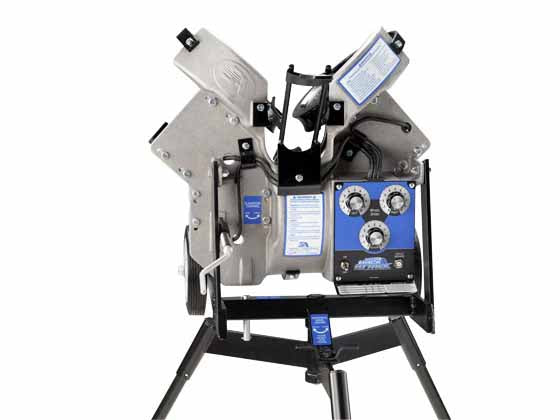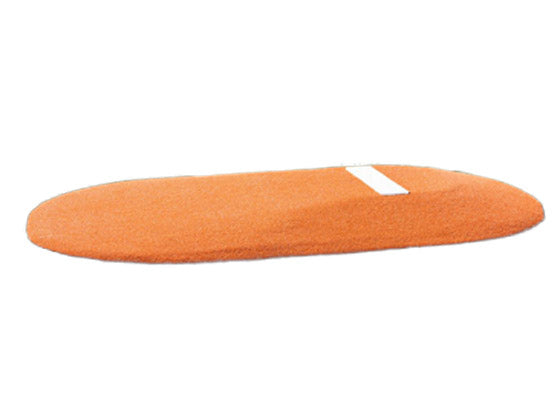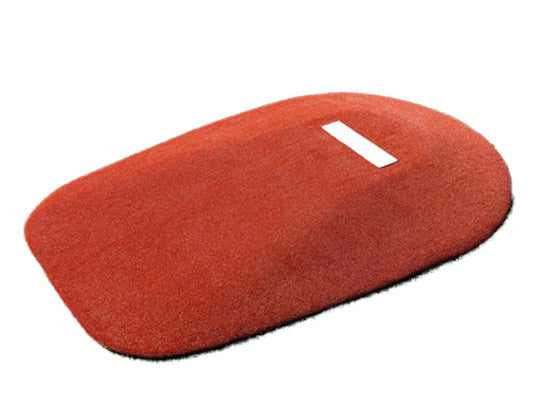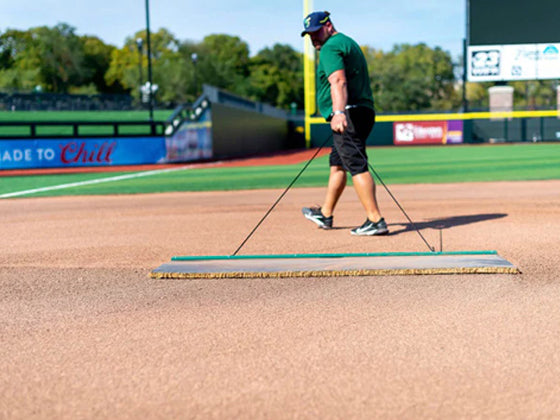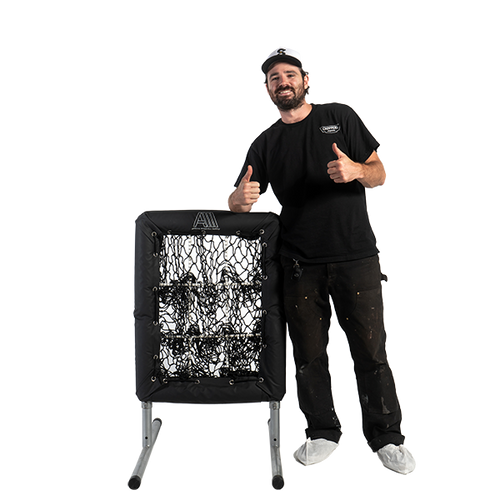Throwing around a baseball in the backyard is easy enough; what if you want to practice batting? Not everyone has access to batting cages at the park or gym. Thankfully, there are alternatives. This article will cover the top-ten BEST batting cages for at-home use in 2025 so you can dominate the league as a home run hitter.
Before we do, let’s cover some basics:
What are the benefits of having a batting cage at home?
Here are some benefits of having a backyard batting cage:
1. Convenience
A home batting cage offers unmatched convenience for your training routine. You can practice anytime without worrying about facility hours or travel time. This flexibility allows you to fit practice sessions into your schedule easily.
2. Improved Skills and Consistency
Consistent and frequent practice in your batting cage helps you to refine your skills, develop muscle memory, and improve hand-eye coordination. You can also focus on specific techniques, like timing and footwork, and simulate game-like conditions.
3. Cost Savings
Owning a batting cage saves significant costs over time. For instance, frequent trips to local batting cages or renting training facilities can add up, but setting up a cage at home eliminates these recurring expenses. This setup becomes even more economical for multi-player households or teams, as multiple people can use the cage without extra fees.
In addition, you can avoid equipment rental fees and can invest in purchase-only items like pitching machines.
4. Allows For Year-Long Usage
Durable batting cages allow you to practice all year round, regardless of the time, place, or weather elements. This consistent availability turns your backyard into a practice field and empowers you to stay prepared for real-life games.
5. Effective Training Environment:
You can add complementary equipment to improve your training within the cage. For example, L-screens and strike zone targets help you practice varied pitching angles and contact precision.
Now, let’s get to the juicy parts!
And if you are interested already, here is our outdoor batting cage collection for you to explore.
Top Ten Best Backyard Batting Cages
Are you considering installing a batting cage in your backyard? If so, you've probably noticed that there are many options, and it can seem overwhelming to determine which are the best for you.
Lucky for you, we created a list of the top 10 best backyard batting cages to help you decide which batting cage is right for you, your kids, and your backyard.
#1. The "Rookie" Complete Backyard Batting Cage
Learn more about the Rookie backyard batting cage.
The Cimarron backyard batting cage has everything you need to set up in your backyard: a durable net, a strong frame, and the hardware to assemble it. This residential batting cage is made with 11/2-inch galvanized steel tubing and polyethylene netting. It is also easy to assemble and will last you many seasons!
Batting Cage Features:
-
Uses durable #24 twisted polyethylene netting
-
Netting is treated with UV protection
-
Comes complete with everything you need for a full residential batting cage
-
Easy to set up
#2. Slugger's Sanctuary 55’ Complete Batting Cage
Learn more about the Slugger's Sanctuary complete backyard batting cage
The Slugger’s Sanctuary is a seriously heavy-duty batting cage that gets the job done. This batting cage has a 2-inch thick steel frame and #42 polyethylene twist netting that can withstand some of the toughest conditions.
It’s also very versatile and comes in multiple sizing options. Make sure you use a rubber batting cage backstop to increase the longevity of the net!
Pros
-
Great for all ages
-
Increases lifespan of netting and withstands harsh conditions
-
A center rope supports the batting cage ceiling
Cons
-
High price point
#3. Heater Sports PowerAlley Baseball & Softball Batting Cage
Learn more about the PowerAlley backyard batting cage.
The PowerAlly is one of the best budget-friendly choices. Though only 22 feet long, its lightweight fiberglass frame offers a super-quick setup.
One key feature of this cage is the built-in pitching machine harness. This allows the pitching machine to remain outside the batting cage, giving the batter the entire field length to react.
Pros
-
Great for ages six and up
-
Easy set up, thanks to its lightweight and small design
-
built-in pitching machine harness allows a batter to use the full batting cage
-
Increase your reaction time with the shorter tunnel length
Cons
-
Smaller size makes it more difficult to track ball velocity off of hits
-
Fiberglass frame comes with decreased strength and durability
#4. Jugs Hit at Home Complete Backyard Batting Cage
Learn more about the Hit at Home batting cage.
The Hit at Home is your best bet for a high-quality cage without breaking the bank. With a length of 45 feet, this batting cage can fit in almost any backyard. Its steel construction and durable net make it a good option for anyone who wants to set and forget it. Throw in a batting cage mat and a portable pitching machine, and you'll be good to go!
Pros
-
Steel frame #27 netting creates a sturdy structure
-
Ultra-strong polyethylene netting is tough and lasts long
Cons
-
High price point for some people
#5. Trapezoid Batting Cage
Learn more about the Trapezoid Batting Cage.
This is one of the simplest yet most effective batting cages on the market. The Trapezoid batting cage comes fully equipped with a (super) durable galvanized steel frame that can hold its own against the hardest of hits.
One of this product's unique features is its freestanding frame structure. The support poles are outside the netting and at an angle, so there is no need for anchoring, and setup is a breeze.
Pros
-
Great for all ages
-
Galvanized steel frame offers easy set up
-
The steel design offers great support and weather-proofing
-
Offered in 35-foot, 55-foot, and 70-foot options
Cons
-
Its unique frame structure makes it susceptible to wind damage
Tip: Use a nine-hole pitching net with your batting cage to give your pitcher additional practice. This will also act as a strike zone for your batter!
#6. Iron Horse Batting Cage
Learn more about the Iron Horse Batting Cage.
The Iron Horse is our newest shoebox-style batting cage system. It bridges the gap between our Commercial cages and fiberglass batting cages, making it an excellent option for serious backyard batters. It also stands strong without sacrificing space or flexibility.
Pros
-
Strong Net – #42 HDPE twine offers the strongest netting available
-
4" steel frame
-
Comes with a vinyl backdrop
Cons
-
Comes at a higher cost
#7. BATCO Foldable Batting Cage
Learn more about the BATCO foldable batting cage.
The BATCO Foldable Batting Cage's open-ended structure distinguishes it from the rest. Its design allows it to be used anywhere—on the field, in the gym, or your backyard.
The BATCO's ultra-wide 18-foot make-up helps batters better understand where their hits will go. If you use this batting cage for a commercial application, we recommend using an Iron Mike arm pitching machine.
Pros
-
Creates ample room for ball tracking and movement
-
Its open design makes it perfect for indoor use
-
Built-in wheels allow ease of movement
Cons
-
Not sturdy when it comes to outdoor winds
#8. Heater Sports Xtender 24 ft. - 72 ft. Batting Cage
Learn more about the Heater Xtender batting cage.
Heater Sports has produced a top-of-the-line batting cage that can be shipped to you and set up without breaking a sweat. It is designed with steel tubing and a flexible fiberglass frame, making it lightweight, portable, and durable.
The Xtender comes in 8 lengths, from 24 to 72 feet. Thus, you can buy the precise length you need for your space.
This batting cage is easy to set up and built to last. Its flexible fiberglass frame can withstand plenty of hits without damage and is protected by foam padding.
Whether you need a compact or full-size batting cage, the Xtender is a solid investment built with high-quality materials.
Pros:
-
Easy Setup and Portable
-
Length options give great choice
-
Affordable
Cons:
-
The lightweight structure can be a struggle if left outdoors
#9. Heater Sports Home Run Backyard Batting Cage
Learn more about the Home Run batting cage.
Big dreams on a small budget? The Home Run backyard batting cage is the right batting cage for you. This cage turns a small portion of your backyard into your kids' dream baseball training ground!
You can save time and money by not taking the kids to the local batting cage. Instead, you can watch them work on their swing from the comfort of your home.
Pros
-
The freestanding and moveable cage allows for quick and easy transport
-
A price of less than $200 is an excellent option for its value
-
It's a great way to do solo batting practice
Cons
-
Lightweight design may affect sturdiness, especially against the elements
-
May wear down from excessive transporting
#10. Mastodon Batting Cage
Learn more about the Mastodon backyard batting cage
We literally saved the best for last. We listed it last because the truth is, it's out of most people's budgets and needs. But it's the best backyard batting cage money can buy. In fact, they are often used in commercial spaces, which just proves their durability.
Pros:
-
Durable 8.25" thick steel steel frame
-
Cable tensioning system
-
#42 bear trap net
Cons:
-
High price point
How to Choose the Right Size of Batting Cage
Selecting the appropriate size for your batting cage ensures it meets training needs and fits your space. Here are some points to consider:
1. What Dimensions Should You Consider?
The dimensions of a batting cage are critical for effective practice. You must match the dimensions with the users' age, skill level, and goals.
-
Length: Most hitters use standard cage lengths ranging from 35 to 70 feet. A 70-foot cage accommodates full swings and pitch trajectories for baseball, while a 55-foot cage is typically required for softball.
Recreational users may opt for a 50-foot minimum, whereas advanced training setups often range from 70 to 100 feet. Shorter cages, measuring 35 to 55 feet, suit younger players or limited spaces.
-
Width: Typical widths are 12 to 14 feet. This size allows for comfortable movement inside the cage without feeling restricted.
-
Height: A height of 12 feet prevents restrictions during batting and ensures safety by allowing high trajectory hits to remain contained.
2. How Much Space Do You Have Available?
Before deciding on a batting cage, carefully evaluate your available space. Accurately measure length, width, and height, and consider your yard's features.
-
Backyard Installations: Compact spaces might limit cage length to 35 or 55 feet, which is sufficient for essential practice. Larger backyards can accommodate cages up to 70 feet or more for optimal functionality.
-
Buffer Zones: Allow clearance around the cage for safe movement and equipment setups, such as pitching machines, without interfering with the surrounding landscape.
-
Ceiling Considerations for Indoor Use: If you’re setting up your cage indoors, match the cage height to ceiling restrictions. Choose shorter or foldable options if ceilings are low.
3. Are You Planning to Use It for Multiple Players?
Determine if your batting cage will serve individual or group training sessions. The size and features depend on the number of users.
-
Single Player Use: Smaller cages, such as 35 or 55 feet in length, fulfill the basic needs for solo practice, such as soft toss or tee work.
-
Multiple Players or Team Use: For team drills or simultaneous use, use larger sizes (70+ feet) to provide sufficient space for pitchers, catchers, and rotating hitters. Standard widths of 12 to 14 feet allow group movement without crowding.
-
Dedicated Features: Longer cages are ideal for defensive training scenarios and allow ample distance for accurate fielding practice. You can customize layouts for alternating batting or pitching stations.
4. What Materials Will You Use?
Batting cage frames come in three primary materials: fiberglass, fiberglass with steel rods, and full steel. Each material offers different benefits depending on your budget and intended usage.
1. Fiberglass:
Fiberglass frames are often used in lower-priced cages. These lightweight frames are suitable for younger or beginner players developing fundamental skills. They can withstand moderate use but may shatter under the impact of hard-hit balls.
2. Fiberglass with Steel Rods:
The combination of fiberglass and steel rods offers a balance of affordability and durability. They are stronger than fiberglass-only options and can handle more frequent use, making them a mid-tier choice for intermediate players.
3. Full Steel:
Steel frames are the most durable and can endure intense, high-impact scenarios. They also resist harsh weather conditions, making them perfect for outdoor or professional-level batting cages. However, steel frames cost more than other materials.
Tip: When selecting the material, consider your players' skill level and how often the cage will be used to maximize value and longevity.
5. Batting Cage Netting
Batting Cage netting quality is another important factor to consider before purchasing a batting cage. Here are the different options:
1. Nylon Netting:
Nylon netting is firm and widely used in professional-tier setups. The netting is (very) durable, but its susceptibility to moisture and UV damage makes it better suited for heavy indoor use or areas with low environmental exposure.
2. Poly Netting:
A newer alternative, poly nets, perform well outdoors due to their superior UV and moisture resistance. They generally cost less than nylon but are slightly less durable indoors under heavy traffic.
Tip: Choose high-quality netting with a durable steel frame for the best blend of usability and long-term value.
How Much Should You Expect to Spend on a Batting Cage?
Generally, prices fall into three categories:
-
Affordable Options:
Basic backyard setups cost between $200 and $799. The Heater Sports Xtender, priced at $299.99, is one of the most affordable backyard batting cages.
-
Mid-Range Options:
More advanced systems cost between $500 and $2,000. They often include professional-quality netting or slightly larger dimensions (e.g., 40-60 feet) suitable for consistent practice.
-
High-End Options:
Professional-grade cages cost between $2,500 and $10,000, with premium systems exceeding $3,500. For example, the Tuff Frame Pro outdoor batting cage costs $15,399. These cages are designed for durability, consistent high-level use, and advanced features like pitching machine compatibility.
7 Maintenance Tips for Your Batting Cage
Implement these tips to keep your equipment in top condition:
1. Inspect Frames and Nets Regularly
Check the frame and netting for signs of wear or damage. Look for rust on steel frames and tears or fraying in the netting. Address issues promptly to prevent further deterioration. For example, small net tears can be repaired using a patch kit, and heavily damaged sections can be replaced.
2. Clean the Batting Cage
Remove dirt, debris, and leaves from the cage to maintain a clean training environment. For routine cleaning, use a soft brush or cloth. For stubborn dirt on netting, spray with water and mild detergent, avoiding harsh chemicals that can weaken the material.
3. Store Equipment During Extreme Weather
Protect your batting cage from severe weather. Dismantle and store portable models indoors during heavy storms or prolonged snow. For permanent setups, secure the netting tightly and cover frames with waterproof tarps to shield against moisture and UV damage.
4. Check Anchors and Tension
Ensure frame anchors and tie-downs remain secure. Loose anchors can compromise stability during practice. Adjust net tension regularly to maintain a proper fit and prevent sagging, preserving optimal functionality.
5. Maintain Additional Equipment
Clean and inspect complementary gear like batting mats, tees, and protective screens. Replace worn or damaged items like L-screens with bent frames, to maintain a safe training setup.
6. Treating Metal Frames
Apply rust-resistant paint or coating to steel frames annually. Preventative treatment blocks corrosion and reinforces the frame’s durability, especially in humid or rainy climates.
7. Monitoring Weather Exposure
Limit prolonged exposure to direct sunlight and rain. UV rays can degrade net material over time, so use a UV-resistant cover when the cage isn’t in use. Keeping frames dry minimizes the risk of rust.
Final Thoughts
Ready to pull the trigger? Look at our entire line of batting cages here. Still need help? Take a look at our batting cage buyer's guide and our top 6 ideas for backyard batting cages.
No matter what you decide, only you know what’s right for your needs. Pick one that will last, is durable, and has all the room required for you or your child to perform efficiently and effectively. Play ball!

 Contact Us
Contact Us